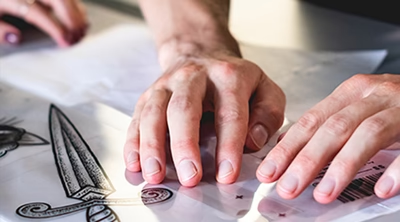Screen Printing vs. Heat Press: What to Choose & Why?
When it comes to customizing garments or printing designs on various surfaces, two popular methods often come into consideration: screen printing and heat press. Both techniques have their merits and differences, making it essential to understand the strengths and weaknesses of each. In this article, we will explore heat transfer vs screen printing, compare their processes, quality, versatility, durability, and cost-effectiveness.
What is Screen Printing & Heat Press?
Screen Printing
Screen printing is a technique that involves transferring ink onto a substrate through a stencil or screen. The process begins by creating a stencil on a mesh screen, where each color of the design requires a separate screen. The screen is then placed on top of the substrate, typically fabric, and ink is applied to the screen's open areas. A squeegee is used to push the ink through the screen, transferring the design onto the substrate. This method allows for precise color registration and is known for its vibrant, long-lasting prints.
Heat Press:
Heat press, also known as heat transfer, is a method of printing designs onto various surfaces using heat and pressure. The process starts by printing the design onto transfer paper or vinyl using a special ink or toner. The printed design is then placed on the desired surface, such as fabric or other materials, and a heat press machine is used to apply heat and pressure. The heat causes the ink or toner to transfer from the paper or vinyl onto the surface, creating the final design. Heat press is often used for personalized customization and is suitable for smaller runs or one-off items. It offers versatility in terms of materials and can be used on fabrics, ceramics, metal, and more.
Difference Between Heat Press and Screen Printing
Process
Screen printing involves creating a stencil or screen for each color used in the design. The stencil is typically made of a fine mesh material stretched tightly over a frame. Areas of the stencil that correspond to the design are left open, while the rest is blocked. Ink is applied to the screen, and a squeegee is used to push the ink through the open areas of the stencil onto the substrate below. This process is repeated with different screens and colors to create multi-color designs.
On the other hand, heat press, also referred to as heat transfer, utilizes heat and pressure to apply a pre-cut or pre-printed design onto a substrate. The design is first printed or cut onto transfer paper or vinyl. The transfer paper or vinyl is then placed onto the substrate, and a heat press machine is used to apply heat and pressure. The heat causes the ink or adhesive on the transfer paper or vinyl to bond with the substrate, resulting in the design being transferred onto the surface.
Quality
Screen printing is renowned for its high-quality, vibrant prints with bold and long-lasting colors. It excels in larger designs and precise color matching, making it a popular choice for various applications. On the other hand, heat press, also known as heat transfer, can also produce high-quality prints, but the outcome may differ from screen printing. The quality of heat press prints, which are created using transfer paper or vinyl, depends on the specific materials used and the capabilities of the heat press machine.
While heat press allows for intricate details and vibrant colors, the resulting prints may have a different feel and texture compared to screen prints. The ink layer in heat press prints is typically thinner, which can affect opacity and color vibrancy. The texture of the transfer paper or vinyl can also influence the tactile experience of the print, with variations such as smoother surfaces or slightly plastic-like textures. Ultimately, the choice between heat transfer vs screen printing depends on factors such as the desired print quality, project requirements, and available resources.
Versatility
Screen printing is a versatile technique applicable to fabric, paper, plastic, metal, and wood. It is used in various industries for apparel decoration, promotional products, signage, and art prints. It is best suited for bulk orders and designs with multiple colors.
Heat press is primarily used for fabric customization, especially on t-shirts, jerseys, and caps. It can also be used on materials like ceramic, glass, and metal. Heat press is ideal for smaller runs and individual customization, making it perfect for personalized designs or one-off items.
Durability
Screen printing offers excellent durability. The thick layer of ink and the curing process make the prints highly resistant to fading, cracking, and washing. Screen printed garments can withstand regular wear and tear, making them suitable for long-term use.
Whereas the durability of heat press prints differs according to various factors, such as the quality of the transfer material and the application process. In general, heat press prints are durable and can withstand regular washing and light wear. However, they may be more prone to fading and cracking over time compared to screen prints.
Conclusion
Choosing between heat transfer vs screen printing depends on various factors, including the desired quality, versatility, durability, and budget constraints. Screen printing excels in vibrant colors, durability, and cost-effectiveness for bulk orders, while heat press offers versatility, individual customization, and convenience for smaller runs. Consider the specific requirements of your project to determine which method (screen printing heat press) suits your needs best.

.webp)


Comments
Post a Comment